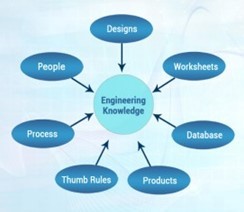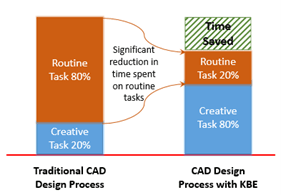
Significant portion of the knowledge base for engineering product development is in tacit form and is in the head of experienced specialized engineers whom we call as Subject Matter Experts (SMEs). Knowledge Based Engineering addresses this issue by using Knowledge Based Systems Technology to capture the knowledge created and used during the product development process and to facilitate re-use of the knowledge in development of a new product of similar product family. Adoption of KBE is not an easy task and involves certain set of challenges. But the benefits of KBE outweigh the effort required to overcome the challenges and makes it attractive for any organization to adopt KBE.
KBE Value Addition

Knowledge re-use of KBE can save considerable time, cost and efforts at design phase. Identifying and standardizing the design decisions as part of implementing KBE also drastically reduces the time spent on repetitive tasks thus allowing the engineer to spend more time on creative tasks.
KBE Solutions
CADVision with the combined skills of Domain experts, Design consultants, CAD experts and Software Product Development can provide to the customers the required KBE solutions. CADVision works closely with its clients at each and every step of the KBE development process and help them realize the maximum benefits of their KBE application.
CADVision with its extensive knowledge on developing CAD automation is well equipped to do template management, parametric models management, design automation, integration with other systems and generating well-structured reports. Our solutions are tailor made as per client requirements.
Benefits of Using KBE
- Reduced lead time – Design process is automated using the data from Knowledge Based Systems
- Knowledge re-use – Information is captured, structured and stored inside the system
- Product optimization – Faster design cycle means more trials to arrive at optimal design
- Allows interdisciplinary exchange of knowledge – Information can be shared for documentation and collaboration.
- More time for innovation – As routine tasks are automated, extra time is used for innovation
